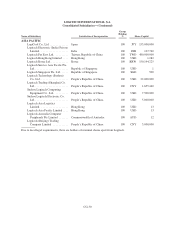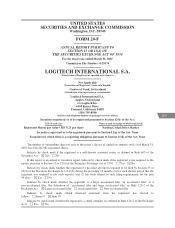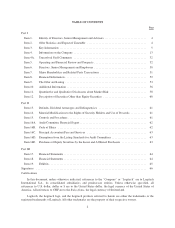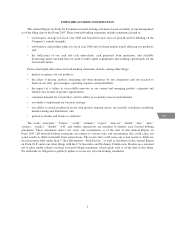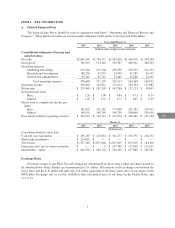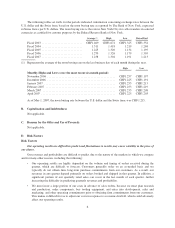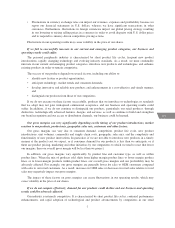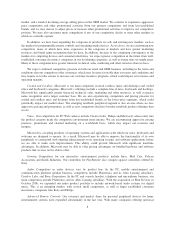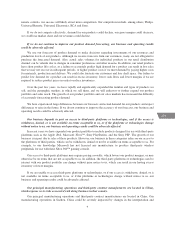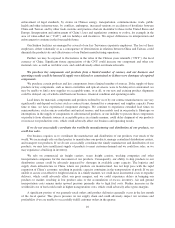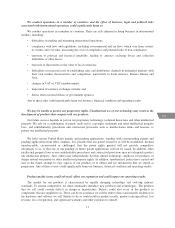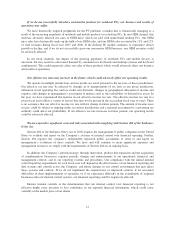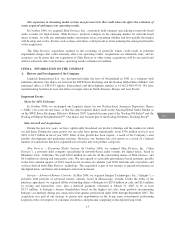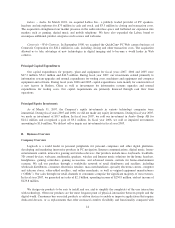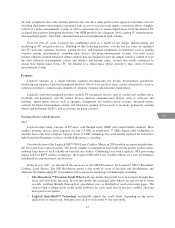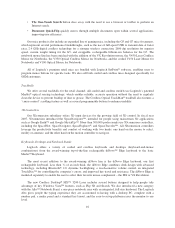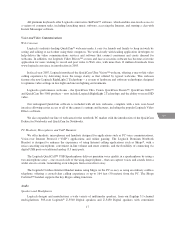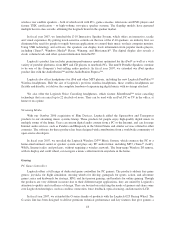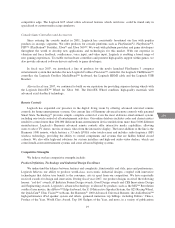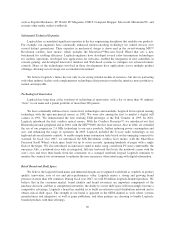Logitech 2007 Annual Report Download - page 62
Download and view the complete annual report
Please find page 62 of the 2007 Logitech annual report below. You can navigate through the pages in the report by either clicking on the pages listed below, or by using the keyword search tool below to find specific information within the annual report.enforcement of legal standards, by strains on Chinese energy, transportation, communications, trade, public
health and other infrastructures, by conflicts, embargoes, increased tensions or escalation of hostilities between
China and Taiwan, and by other trade customs and practices that are dissimilar to those in the United States and
Europe. Interpretation and enforcement of China’s laws and regulations continue to evolve, for example in the
area of value-added tax (“VAT”) and tax holidays and incentives. We expect differences in interpretation and
enforcement to continue in the foreseeable future.
Our Suzhou facilities are managed by several of our key Taiwanese expatriate employees. The loss of these
employees, either voluntarily or as a consequence of deterioration in relations between China and Taiwan, could
diminish the productivity and effectiveness of our Suzhou manufacturing operations.
Further, we may be exposed to fluctuations in the value of the Chinese yuan renminbi (“CNY”), the local
currency of China. Significant future appreciation of the CNY could increase our component and other raw
material costs, as well as our labor costs, and could adversely affect our financial results.
We purchase key components and products from a limited number of sources, and our business and
operating results could be harmed if supply were delayed or constrained or if there were shortages of required
components.
We purchase certain products and key components from a limited number of sources. If the supply of these
products or key components, such as micro-controllers and optical sensors, were to be delayed or constrained, we
may be unable to find a new supplier on acceptable terms, or at all, or our new and existing product shipments
could be delayed, any of which could harm our business, financial condition and operating results.
Lead times for materials, components and products ordered by us or by our contract manufacturers can vary
significantly and depend on factors such as contract terms, demand for a component, and supplier capacity. From
time to time, we have experienced component shortages. We continue to experience extended lead times on
semiconductors, such as micro-controllers and optical sensors, and base metals used in our products. Shortages or
interruptions in the supply of components or subcontracted products, or our inability to procure these components
or products from alternate sources at acceptable prices in a timely manner, could delay shipment of our products
or increase our production costs, which could adversely affect our business and operating results.
If we do not successfully coordinate the worldwide manufacturing and distribution of our products, we
could lose sales.
Our business requires us to coordinate the manufacture and distribution of our products over much of the
world. We increasingly rely on third parties to manufacture our products, manage centralized distribution centers,
and transport our products. If we do not successfully coordinate the timely manufacture and distribution of our
products, we may have insufficient supply of products to meet customer demand and we could lose sales, or we
may experience a build-up in inventory.
We rely on commercial air freight carriers, ocean freight carriers, trucking companies and other
transportation companies for the movement of our products. Consequently, our ability to ship products to our
distribution centers could be adversely impacted by shortages in available cargo capacity. The logistics and
supply chain infrastructure in China, where our products are manufactured, has not kept pace with the rapid
expansion of China’s economy, resulting in periodic capacity constraints in the transportation of goods. If we are
unable to secure cost-effective freight resources in a timely manner, we could incur incremental costs to expedite
delivery, which could adversely affect our gross margins, and we could experience delays in bringing our
products to market, resulting in lost product sales or the accumulation of excess inventory. Air and ground
transportation costs remain under upward pressure primarily due to high fuel costs. Further increases in the
worldwide cost of fuel could result in higher transportation costs, which could adversely affect gross margins.
A significant portion of our quarterly retail orders and product deliveries generally occur in the last month
of the fiscal quarter. This places pressure on our supply chain and could adversely impact our revenues and
profitability if we are unable to successfully fulfill customer orders in the quarter.
10


